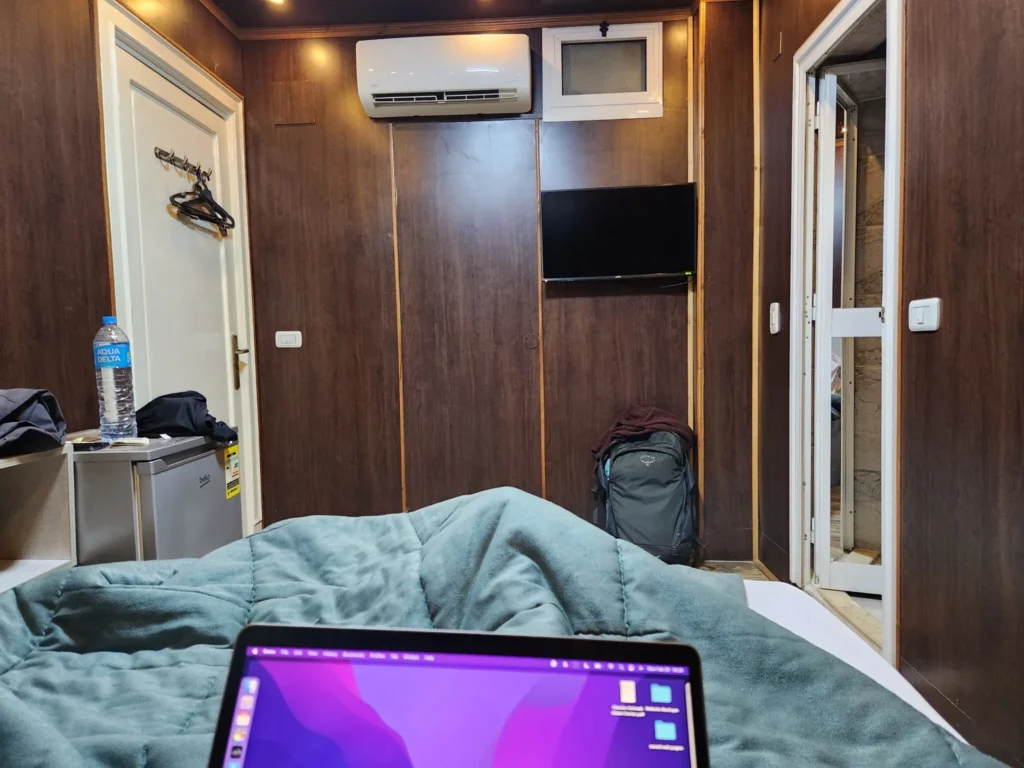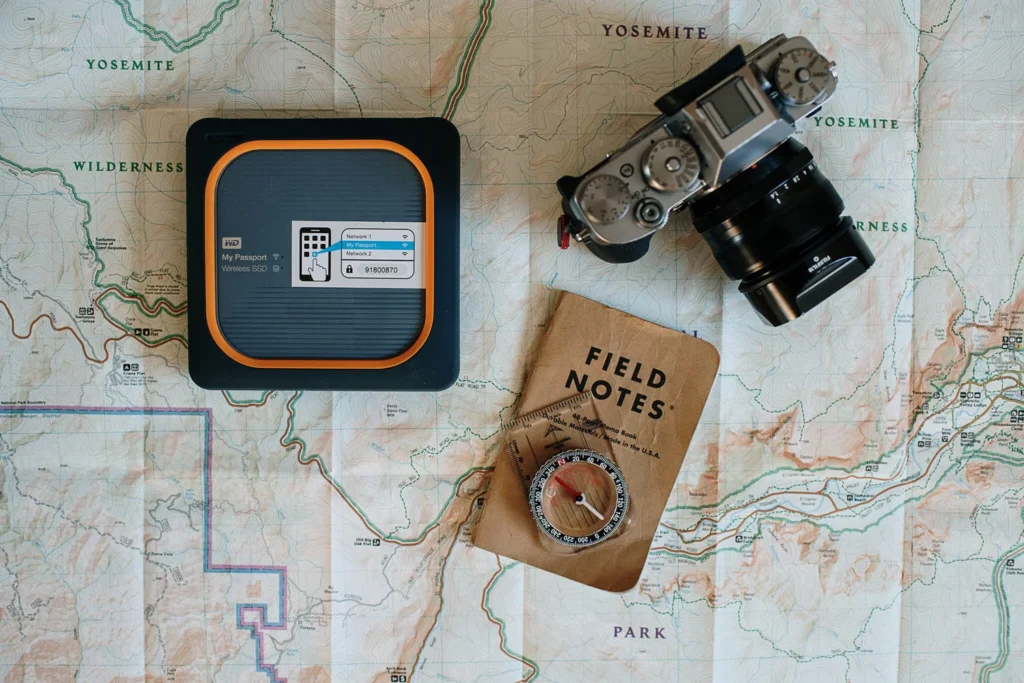For creators who don’t just travel, they translate movement into meaning.
The Moment Before the Flight
Every travel creator knows that the journey doesn’t start at the destination; it begins at the gate. A strong content creation workflow turns those in-between moments into stories that move. Airports hum with a strange kind of stillness: the quiet buzz of waiting, the glow of screens, the rustle of boarding passes.
You sit cross-legged by a charging outlet, laptop open, camera bag unzipped, half dreaming, half planning. Around you, strangers scroll through their phones, killing time before boarding. But for a creator, every minute in transit is currency, another story waiting to be captured, stored, and shaped.
It’s easy to promise yourself you’ll write it later. That you’ll sort through photos once you’ve “settled in.” But later rarely comes. The photos fade into folders, the memories dull, and the spark that made the moment alive turns into a faint recollection.
That’s where the idea of the Airport-to-Airbnb Pipeline begins, not as a productivity hack, but as a creative philosophy. It’s the belief that travel itself can be a studio, that every step, from takeoff to check-in, can become part of a same-day content creation flow.
The goal isn’t to rush; it’s to capture the energy while it’s still warm. To turn every layover into a moment of making. Because what separates casual travelers from creative nomads isn’t gear or glamour; it’s rhythm.
Why You’re Losing Stories at the Gate
Creative decay doesn’t announce itself. It happens quietly, between landing and unpacking, between exhaustion and distraction. You tell yourself you’ll remember that view from the plane window, the scent of jet fuel and morning rain, the soft panic of a missed connection. But memory is a poor archive.
The truth is that creative energy has a half-life. The longer you wait to process it, the more it fades. “I’ll edit later” is the biggest lie every creator tells themselves, because later, you’re in another timezone, another mindset, and the magic of that moment is gone.
Professional storytellers know this instinctively. They don’t just travel; they document as they go. Their workflow isn’t an afterthought; it’s the skeleton of their craft. They shoot, they back up, they tag, and they draft in the same breath. Not because they’re in a rush, but because they respect the fragility of inspiration.
The Airport-to-Airbnb Pipeline is built on this same truth. It’s about momentum. The faster you capture and process what you’ve lived, the more honestly you can tell it. Waiting kills immediacy; same-day creation preserves it.
Stage One: Capture – The Art of Seeing While Moving
Travel tempts you to record everything, but the real art lies in knowing what to keep. Capture isn’t about hoarding; it’s about seeing with intention. Every airport lounge, taxi window, and boarding line holds a micro-story, but most people walk past them in a hurry to get somewhere else. Creators pause, even for half a second, to notice.
As you move through terminals, pay attention to the ordinary. The reflection of departure boards on your coffee cup, the half-asleep family by the gate, the texture of your boarding pass between your fingers — these are the details that anchor memory and make your stories believable later.
Capturing while moving doesn’t demand expensive gear. It’s about instinct, about training yourself to think like a storyteller even when you’re exhausted. Sometimes the best shots come when you’re least prepared: a fleeting cloud shadow on the runway, or a quiet smile from someone across the aisle.
A voice memo helps, too. Record thoughts between flights, even if they’re messy. A five-second note, “gold light on wing, smells like rain,” can later expand into a full paragraph that feels alive. You’re not just documenting where you went, but how it felt to be there.
Capture is the heartbeat of this pipeline. You’re not chasing perfection — you’re simply catching the truth before it slips away.

Stage Two: Backup – The Ritual That Saves Sanity
There’s a certain comfort in routine, even amid chaos. For creators, that routine begins with backup. It’s the quietest, most sacred part of the workflow; the moment you exhale and tell yourself, it’s safe now.
Every seasoned nomad has a story about the footage that got away. A misplaced SD card. A stolen phone. A coffee spill on a hard drive. These moments don’t just cost data; they cost time, memory, and sometimes even motivation. The simple act of backing up immediately, before the next leg of your journey, can save you from heartbreak.
Picture this: you’re sitting in an airport café, the buzz of departure announcements in the air. Your laptop hums softly as files transfer to your external SSD. You name the folder “2025-10-22_LisbonTransit” instead of “DCIM_0198.” You upload the most important shots to cloud storage while sipping coffee. Twenty minutes later, your creative universe is secure.
It’s not about paranoia; it’s about mental clarity. When you know your work is safe, your mind stays light. You move on to the next city with confidence, ready to create again. Backup isn’t busywork; it’s a declaration that your work matters enough to protect.

Stage Three: Tag – Memory Anchors for the Future Self
Tagging is one of those unglamorous habits that separate the chaotic from the consistent. It’s not just about finding things later; it’s about preserving context. When you tag something, you’re telling your future self what this moment meant.
Think of each tag as a breadcrumb in the forest of your memory. Label your footage with place, emotion, or theme. “2025-10-22_IstanbulTransit_MorningHaze.” That one phrase carries the light, the time, and the atmosphere. Two years from now, when you stumble upon it again, those three words will pull you right back to that airport seat, coffee in hand, watching dawn rise through glass.
The key is to do it immediately. Don’t wait until you’re home. Tagging is part of the ritual, as essential as capturing or backing up. It’s your dialogue with your future creative self.
When your system is simple and consistent, your storytelling gains clarity. You don’t waste time searching; you build faster. Over time, you’ll start tagging not just by place or time, but by mood: “Restless,” “Serene,” “RushHourEnergy.” These emotional cues bring back details far more vividly than numbers ever could.
Tagging is not administration; it’s storytelling architecture.
Stage Four: Draft – The Jet-Lag Journal
The best time to write isn’t when you’re rested — it’s when you’re still vibrating from the journey. When your head hums with leftover noise and the world feels too bright. That’s when your writing carries truth.
Drafting the same day doesn’t mean crafting polished work. It means unloading. Capture the mood before it escapes. Write while you’re still half in the moment — at the gate, on the plane, or sprawled on the Airbnb bed with your shoes still on.
Start with fragments. Sentences that don’t yet make sense. “The man in front of me dropped his boarding pass twice.” “Smell of soap and jet fuel.” “City lights look like scattered thoughts.” Don’t edit; just pour.
By morning, these scattered notes form a living draft; a story that still breathes from the same air you experienced. The words might wobble, but they’re honest. You can polish later. For now, you’ve kept the pulse alive.
Same-day drafting builds momentum. It’s not about speed; it’s about emotional fidelity; about catching the feeling while it’s still real. You’re not just recording travel; you’re translating immediacy.

Why Same-Day Pipelines Build Stronger Brands
In the creator economy, timing isn’t everything, but it’s close. The internet rewards freshness, and audiences reward presence. Posting in real time doesn’t just keep your feed alive; it keeps you alive inside your brand.
The Airport-to-Airbnb Pipeline isn’t about hustling harder. It’s about creating smarter. When you move through your workflow: capture, backup, tag, and draft all within the same day, your brand starts to feel organic. Your audience feels that you’re not performing travel; you’re living it.
That immediacy builds trust. Readers can tell when a post was written in the echo of an experience versus months later. Your voice is warmer, your details sharper, your honesty more tangible. It’s what turns followers into loyal readers, and loyal readers into advocates.
Consistency doesn’t come from discipline alone; it comes from rhythm. Once this system becomes your second nature, your creative life flows wherever you go.
A Real-World 12-Hour Travel Day
Imagine a day that begins with the hum of a 6 a.m. flight. You capture everything: the soft morning light on your window, the airport’s sleepy rhythm, the quiet chaos of boarding.
By the time you land for your layover, your laptop becomes your sanctuary. You find a corner seat by the charging port, order a coffee, and begin your backup ritual. Files slide safely into their folders. You rename, tag, and breathe. The hum of travelers becomes white noise as you anchor your stories into order.
By evening, you’re checking into your Airbnb. The air smells different. The city pulses beyond your window. You should sleep, but your mind won’t let you, so you write. A short draft. A few lines. A paragraph that might later grow into a post.
And that’s it, the full pipeline in motion, lived within twelve hours. You’ve turned a travel day into creative momentum, preserving experience as it unfolds. Tomorrow, you’ll wake up not to start over, but to continue the rhythm.

Travel as Creative Infrastructure
In the end, travel isn’t a break from creation; it is creation. Every gate, every checkpoint, every borrowed bed is part of your creative ecosystem. The Airport-to-Airbnb pipeline teaches you to see transit not as a pause, but as a pulse, a living studio stretched across time zones.
When you treat travel as infrastructure, everything changes. Airports become editing rooms. Airbnbs become writing retreats. Waiting rooms become brainstorming spaces. You’re no longer chasing time; you’re using it.
Because the truth is, stories don’t wait for comfort. They happen mid-flight, mid-chaos, mid-thought. The creator who learns to work within that rhythm becomes unstoppable.
So the next time you’re at a gate, tangled in cables and thoughts, remember this:
You’re not just waiting to go somewhere. You’re already inside the story.
“If airports are your waiting rooms, make them your studios.
The story doesn’t start at the destination, it starts at Gate 42.”
FAQs
How do I stay consistent with this same-day pipeline when I’m exhausted from travel?
The trick is to reframe it as unloading your mental backpack, not a task. Once you’ve built templates for file names, tagging, and draft layouts, the workflow runs on autopilot. A 20-minute ritual before bed becomes the reset that keeps your creative rhythm alive, even on the road.
What’s the best setup for creators with limited gear or slow Wi-Fi?
Keep it minimal: a smartphone, a small SSD, and an offline note-taking app like Notion or Obsidian. Use mobile Lightroom for quick edits and backup to physical storage first, then cloud-sync later when the connection improves. The pipeline isn’t about high-end gear, it’s about discipline and immediacy.
Should I post directly from the airport, or wait until I’m settled at my Airbnb?
It depends on the goal. Airports are perfect for drafting and organizing, you’re mentally fresh and still in the travel headspace. But for publishing, the Airbnb phase allows you to refine tone, add metadata, and check visuals under better lighting. Capture raw energy early, polish later.
How do I avoid burnout while keeping up with a same-day content workflow?
Design your pipeline to be modular, not rigid. If one day drains you, only do the capture and backup stages. Tagging and drafting can wait till the next morning. The system exists to serve your creativity, not the other way around. Sustainable pace > perfect output.
How can I make my content stand out when every traveler is posting similar photos and reels?
Originality lies in voice and timing. When you draft the same day, your words carry the raw, unfiltered emotion of experience, something algorithms can’t replicate. Instead of chasing aesthetics, focus on micro-moments, the texture of jet lag, the overheard conversations, the odd things you notice before everyone else does.





0 Comments